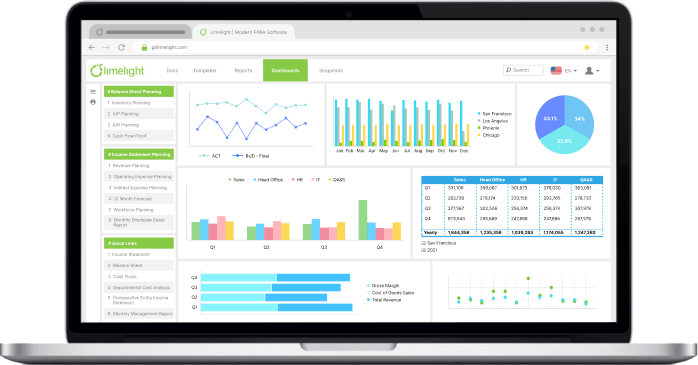ERP
2025's Top Accounting Software Add-Ons: Grow Your Business with These Powerful Integrations
By Limelight Team |
Published: March 26, 2024
By Limelight Team |
Published: March 26, 2024
The finance landscape is evolving at record speed. Siloed data and manual entry are becoming a distant memory. Forward-thinking finance teams are embracing a new era of FP&A, powered by cutting-edge technology. These tools automate tasks, streamline processes, and unlock game-changing insights, enabling finance to become a strategic partner in driving business success.
That's where accounting software and ERP add-ons come in – these specialized tools supercharge your existing ERP system, taking your finance function from "spreadsheet hell" to a strategic powerhouse.
In 2025, we're witnessing a surge in automation across the finance tech stack.
If your business runs on Sage Intacct, Sage 300, Oracle NetSuite, Microsoft Dynamics, QuickBooks Online, Xero, Epicor, or any other ERP, here's a breakdown of some key areas where add-ons are revolutionizing finance functions:
Challenge: Traditional planning processes can be cumbersome and time-consuming, often relying on spreadsheets and manual data manipulation.
Solution: Limelight Software and Prophix
Overview: Limelight and Prophix are budgeting applications that empower finance teams with features like flexible budgeting, scenario modeling, and real-time adjustments. These features, along with dynamic filters and centralized calculations, streamline analysis and ensure data accuracy.
Challenge: Month-end close can be a chaotic and stressful time for finance teams, riddled with manual reconciliations and errors.
Solutions: Blackline and FloQast
Overview: Blackline and FloQast automate tasks like reconciliations, account matching, and task management. These tools improve efficiency, reduce errors, and allow teams to close the books faster.
Challenge: Modern ERPs generate vast amounts of data, but extracting meaningful insights can be challenging.
Overview: Power BI, and Domo provide user-friendly dashboards, visualizations, and reporting tools. Finance teams can easily analyze trends, identify performance gaps, and make data-driven decisions.
Challenge: Managing invoices can be a time-consuming and error-prone process. Paper invoices require manual processing, while electronic invoices can be scattered across various systems.
Solutions: Bill.com, Yooz, and Tipalti
Overview: These tools streamline invoice capture, approval workflows, and payments. These tools improve efficiency, reduce costs, and enhance visibility into payables.
Challenge: Collecting payments from customers can be slow and inefficient, leading to cash flow issues.
Solutions: HighRadius, Versapay, and BlueSnap
Overview: These applications automate tasks like sending invoices, collecting payments, and managing disputes. These tools improve collection rates, reduce delinquencies, and ensure a smoother AR process.
Challenge: Managing employee expenses can be complex, with paper receipts and manual reporting leading to errors and inefficiencies.
Solutions: Expensify, Corpay, and Emburse
Overview: These tools simplify expense tracking and approvals. These tools offer features like mobile receipt capture, automated reports, and corporate card integration, leading to increased visibility and control over spending.
The ideal add-on landscape will vary depending on your specific needs and budget. Here are some key factors to consider when making your selection:
By embracing the power of add-ons, finance teams can unlock a new level of efficiency, accuracy, and data-driven decision-making. Exploring solutions that address your specific challenges will allow you to build a robust and automated finance tech stack, enabling your team to focus on strategic initiatives and drive business success.
The top add-ons in 2025 include:
FP&A Software: Limelight, Prophix
Close Management: BlackLine, FloQast
Business Intelligence (BI): Power BI, Domo
Accounts Payable (AP) Automation: Bill.com, Yooz, Tipalti
Accounts Receivable (AR) Automation: HighRadius, Versapay, BlueSnap
Spend Management: Expensify, Corpay, Emburse
Start by identifying your finance team’s biggest challenges—whether it’s slow month-end close, poor cash flow visibility, or manual data entry. Then, ensure the add-ons integrate smoothly with your ERP, can scale as your business grows, and have strong security features to protect financial data.
Yes. Most of the tools mentioned—such as Limelight, BlackLine, Bill.com, and Expensify—offer direct integrations with leading ERP systems including Oracle NetSuite, Microsoft Dynamics, Sage Intacct, QuickBooks Online, Xero, and Epicor.
While ERPs are powerful, they often lack specialized automation features. Add-ons help fill those gaps—automating reconciliations, streamlining AP/AR, improving planning accuracy, and offering deeper data insights that core ERP systems may not provide.
By automating repetitive tasks and improving data accuracy, add-ons allow finance teams to:
Close books faster
Reduce errors and manual work
Improve cash flow and collections
Gain real-time visibility into expenses
Focus more on strategic, data-driven decision-making
Subscribe to our newsletter


